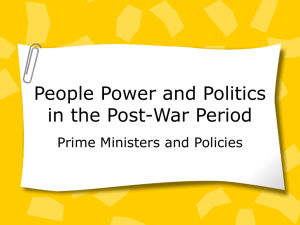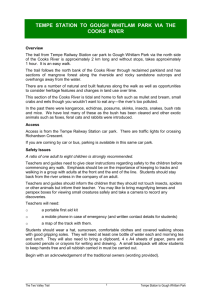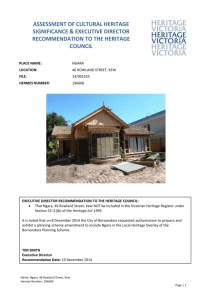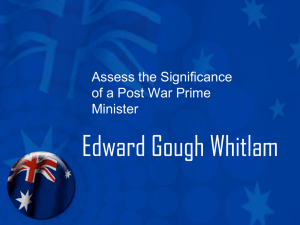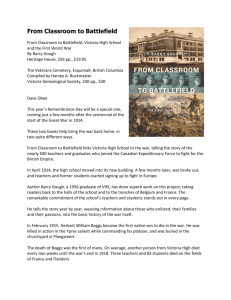heritage citation - City of Boroondara
advertisement
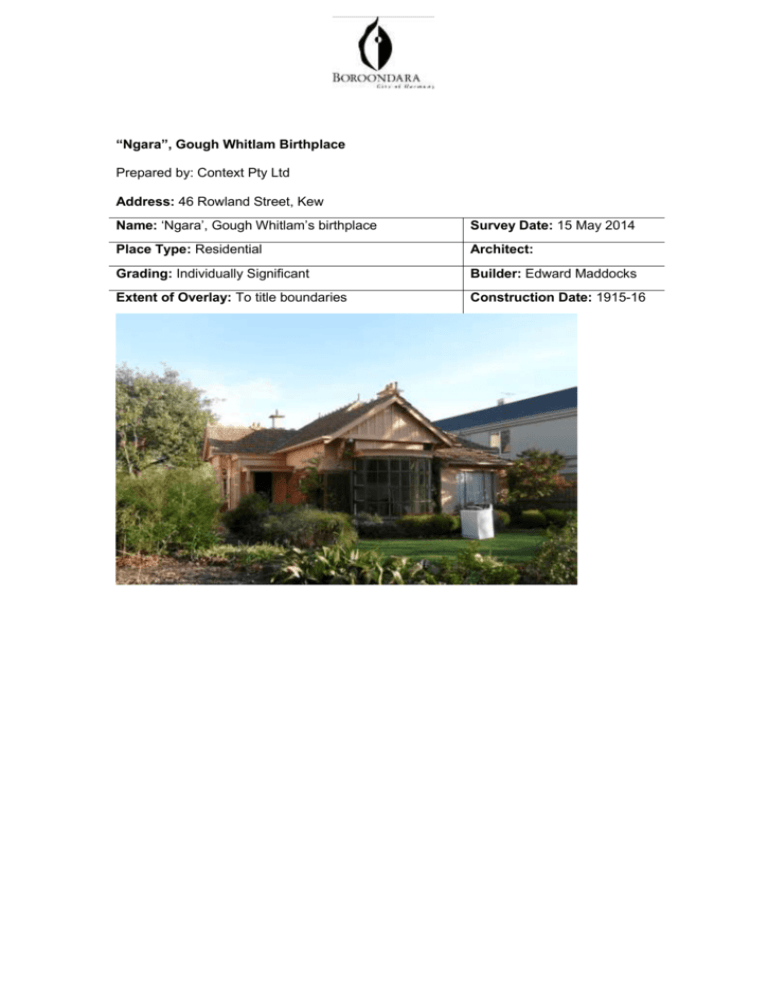
“Ngara”, Gough Whitlam Birthplace Prepared by: Context Pty Ltd Address: 46 Rowland Street, Kew Name: ‘Ngara’, Gough Whitlam’s birthplace Survey Date: 15 May 2014 Place Type: Residential Architect: Grading: Individually Significant Builder: Edward Maddocks Extent of Overlay: To title boundaries Construction Date: 1915-16 Historical Context The land occupied by 46 Rowland Street was originally part of the large land holding acquired by Captain Edward Dumaresq at sale in October 1851. Many of the streets in the vicinity of the subject property are named for Captain Dumaresq's sons - Alfred, Edward, John, Thomas, and Rowland (Rogers, 1973:12-13). Early development along Rowland Street lagged behind that of the adjacent Sackville Street, where many large villas and mansions had been built by 1904, with outbuildings backing onto Rowland Street. The only exceptions were to the east of John Street, with St Hilary’s Church of England on the north side and the vicarage across the street at 34 Rowland Street (HO338) (MMBW Detail Plans Nos. 1569 & 1568, 1904). It was not until the 1910s that the subdivision and sale of the south side of Rowland Street, to the east of John Street, took off. Owner Walter Hiscock, an accountant, purchased over six acres, almost all of it on Rowland Street, and that same year began to sell off individual house blocks measuring 66 feet wide and 189 feet 9 inches deep. The fourth sale, in 1914, was to the future parents of Gough Whitlam (LV: Vol. 3583 Fol. 481). History Edward Gough Whitlam, future Prime Minister of Australia, was born on 11 July 1916 to Harry Frederick (“Fred”) Whitlam and Martha (“Mattie”) Whitlam nee Maddocks. Their first-born child was named after his respective grandfathers: Henry Hugh Gough Whitlam and Edward Maddocks (Hocking, 2008:25; Vic. Birth Cert. 1916/22079). According to the birth announcement, this took place at “Ngara”, Rowland Street, East Kew (Argus, 22 Jul 1916: 13). Fred Whitlam and Mattie Maddocks had wed on 10 September 1914 at the Collins Street Baptist Church (Hazlehurst, 2002). It is not clear where the couple first resided, as some sources give their first residence as Serrell Street, Malvern East (Sands & McDougall, 1915; Hocking, 2008:24), while legal documents from late 1914 and early 1915 give it as Torrington Street, Balwyn (now Canterbury) (LV: Vol. 3856 Fol. 071; MMBW Drainage Plan No 98321). In any case, the couple purchased a block of land on Rowland Street on 18 December 1914 (LV: Vol. 3856 Fol. 071). By February 1915 plans for a new house on this site were complete, and ‘agent’ E. Maddocks of Station Street, Box Hill, applied for a sewer connection on behalf of owner F. Whitlam (MMBW Drainage Plan No 98321). The ‘agent’ shown on the plan of drainage was typically the builder or architect of a new building to be hooked up to the sewerage system. In this case it is known that Mattie Whitlam’s father, Edward Maddocks, was a master builder (Hocking, 2008:25). By the time of his death, in 1938, Edward Maddocks resided on Tower Street, Hawthorn East, in a house he reportedly built as well (Argus, 17 Oct 1938:14; Hockings, 2008: 23). The Whitlams took a mortgage out from the State Savings Bank of Victoria on 30 January 1915, presumably under the Credit Foncier programme to finance construction of the house (LV: Vol. 3856 Fol. 071). No architect has been identified for the house at 46 Rowland Street, and it may well have been the design of Edward Maddocks.* The house was completed by May 1915, and Harry F. E. Whitlan [sic] is listed as residing at 46 Rowland Street in the 1916 street directory (MMBW Drainage Plan No 98321; Sands & McDougall, 1916). Fred Whitlam was born in Prahran in 1884, and became a clerk in the Victorian Department of Lands and Survey in 1901, before moving to the Commonwealth Public Service in 1911 at the land tax branch of Treasury. At the same time he obtained accountancy and legal qualifications, and moved to the Commonwealth Crown Solicitor’s Office in 1913, just before his marriage. In 1917 Fred Whitlam was promoted to senior clerk and then moved to the Sydney office in 1918 (Hazlehurst, 2002). This led to the sale of the family home on Rowland Street on 25 October 1917 just prior to the move (LV: Vol. 3856 Fol. 071). Fred Whitlam and family then moved to Canberra in 1927 to become assistant crown solicitor and was crown solicitor from 1936 until his retirement in 1949. He was a major community figure in Canberra, lecturing at and serving on the council of Canberra University College, serving as president of the University Association of Canberra and the Young Men’s Christian Association of Canberra (Hazlehurst, 2002). While Fred and Mattie Whitlam’s daughter, Freda, would become principal of the Presbyterian Ladies’ College, Croydon (Sydney), and a moderator of the NSW Uniting Church Synod, it was their son, E Gough Whitlam, born at 46 Rowland Street, who would become the most famous of their offspring (Hazlehurst, 2002). Gough Whitlam began his schooling in Sydney, completing his leaving certificate in Canberra after the family moved there in 1927. From 1935 he studied law and arts at the University of Sydney. During World War II he was a Flight-Lieutenant navigator in the Royal Australian Air Force, and married Margaret Dovey in 1942. At war’s end, in 1945, he joined the Australian Labor Party, and won his first Federal seat in 1952. Whitlam was elected leader of the Labor Party in 1967, and brought the party to Federal election victory in 1972, after 23 years in Opposition, becoming the 21st Prime Minister of Australia. During the three short years of the Whitlam Government, numerous reforms and innovations were introduced that showed a clear break with the past and still inform Australian life today. These include ending the draft and involvement in the Vietnam War, establishing diplomatic relations with China, creation of the Department of Aboriginal Affairs, introduction of welfare payments for single mothers and the homeless, lowering the voting age to 18, abolishing university fees, introducing no-fault divorce, replacing ‘God Save the Queen’ as the national anthem, and granting Papua New Guinea independence (‘A timeline of Gough Whitlam’s life’, Herald Sun, 17 Mar 2012). The Whitlam Government was dismissed by Governor-General, Sir John Kerr on 11 November 1975, following a loans scandal and blocking of Federal money supply by a Liberal-Country Party controlled Senate. In the subsequent election, the Labour Government was replaced by the Liberal-Country Party, led by Malcom Fraser. Gough * Note that the State Savings Bank of Victoria only began to provide standard houses designs and specifications along with the Credit Foncier loans in 1924, so the design of the house would not have been provided by the bank (Cooch, 1934:102). Whitlam then lost his seat in the 1977 federal election, and retired from politics the following year. In the following decades he served as a fellow and visiting professor at Australian and American universities, wrote books about his time in politics, and served on a number of national and international councils and committees. He retired from public life around 2010 and suffered the death of his wife, Margaret, in 2012 (‘A timeline of Gough Whitlam’s life’, Herald Sun, 17 Mar 2012). When the Whitlams sold the house at 46 Rowland Street in 1917 it was transferred to the Starr-Bowkett Building Society, which was providing co-operative finance for Samuel James Woods, a tailor and mercer, and Mabel Lucy Woods. The property did not pass into their names until 1932 (LV: Vol. 3856 Fol. 071). Later owners, the Swinnertons, made a number of alterations to the house in the late 1950s and early 1960s, optometrist William Swinnerton acting as owner-builder. Apart from a brick garage in 1955 and a steel garage in 1962, Swinnerton made a series of alterations to the front of the house. In 1959 he extended the front bay window, doubling its depth and adding a bowed multi-pane window influenced by the Georgian Revival style. That same year it appears that he enclosed the original entry porch in a re-entrant corner on the east side of the house, and extended it to the north with a new open porch. This was done in a sympathetic manner and appears to have recycled an original turned timber post. In 1962 Swinnerton enclosed the original front verandah on the west side of the façade, removing the paired verandah posts and building brick walls (City of Kew building permit files). The hip tiled verandah roof, which extends from the main roof, was left intact. A ‘family room’ was appended to the rear of the house at an unknown date. Description & Integrity The house is a modest-sized Federation villa with tuckpointed brick and roughcast walls, and a high pyramidal roof with an asymmetric composition created by half-timbered gabled bays to the front and side elevations. The roof is covered in Marseille tiles with terracotta ridgecapping and finials, and its line is continued down to the front verandah, typical of the style. The four chimneys show an Arts & Crafts influence with roughcast shafts, and flat copings resting on brick headers. Original windows to the side elevations retain floral leadlight casement windows, typical of the time. This includes the bow window to the east elevation which sits beneath a hood supported on decorative timber brackets. Similar brackets sit beneath the jettied apex of the projecting gables. As noted in the history, there have been alterations to the front of the house. These include the replacement of the front bay window with a larger, Neo-Georgian one, though the half-timbering directly above it has survived. The original window was the same size and presumably had the same details as the surviving bay window on the west elevation. An enclosed vestibule was created at the front entrance, on the west elevation. The porch protecting the front door retains a turned timber post which appears to have been reused from elsewhere in the house (likely from the original entry porch). Finally, the front verandah on the east side of the façade was infilled with rendered brick walls. The new walls are set beneath the original verandah roof, indicating its former presence. Comparative Analysis The house at 46 Rowland Street is a Federation villa which displays features typical of this style, in a form that suggests it was designed by a builder (namely, master builder Edward Maddocks) as opposed to an architect. There are many such houses as this, scattered around Kew and the City of Boroondara. Their architectural design generally places them in the category of ‘contributory’ buildings if in a heritage precinct, while a few might be judged ‘notable examples’ of their class (middle-class Federation villas). One of the requirements to be a ‘notable example’ (and meet the threshold of local significance under HERCON Criterion D – representativeness) is a high level of intactness, among other things. As the house at 46 Rowland Street has suffered some external alterations visible from the public domain – particularly the infilling of the front verandah and the enlargement of the front bay window – it clearly falls short of this requirement. The other two architectural criteria – E and F – require an even higher standard of design, so a ‘typical’ example such as this one would – again – not qualify. For these reasons, comparative analysis of the house has not been carried out on an architectural basis. Instead, places given heritage protection because of their associations with a famous person were used as a comparative basis. Two types of such places were sought: those that served as a residence of a prime minister, and those that were the birthplace of a prime minister or famous person of any type. As such places are not numerous, a statewide search was carried out using the Victorian Heritage Database. There are a number of places individually listed on municipal heritage overlays (as well as the Victorian Heritage Register) because they served as the residence of a prime minister during his time in office. As Melbourne served as the national capital until 1927, prior to this all Australian prime ministers had a residence in Melbourne during their time in Parliament. - Boroondara HO315 – 10 Howard Street, Kew. A handsome and intact two-storey house built in 1912. Robert Menzies owned and occupied it 1928-60, encompassing his time as prime minister. - Boroondara HO285 – 167 Cotham Road, Kew. A single-storey double-fronted Federation-style villa of brick construction, which features a distinctive centrallyplaced square porch with Art Nouveau parapeted walls. Intact apart from a rear extension. Built in 1911, it was owned and occupied by Billy Hughes 1915-24, during his time as prime minister. - Southern Grampians HO375 – “Nareen”, Colraine-Nareen Road, Nareen. A Victorian timber homestead owned by the Fraser family 1946-2000 and closely associated with Malcom Fraser during his time as prime minister in the 1970s. The gardens were developed by Malcolm and his wife Tamie. - VHR H1126 – “Ballara”, 57-73 Glaneuse Road, Point Lonsdale. An early bungalow built in 1907-08 as a holiday home for then-prime minister Alfred Deakin. - VHR H1998 – “Bruce Manor”, 34 Pinehill Drive, Frankston. An architectdesigned, Mediterranean Revival villa built for Stanley Bruce in 1926, during his time as prime minister. He left Australia in 1932. The house is intact and its design was influential at the time. - Moreland HO298 – 2 Fallon Street, Brunswick. A typical block-fronted timber house of c1906, with a high level of intact detail. It was rented by John Curtain from 1913-15 during his days as an anti-conscriptionist, prior to his WWII-time term as prime minister. The house is of architectural significance and historic interest only for its ‘brief association’ with John Curtain. The following examples are protected primarily (or equally with other reasons for significance) because they are the birthplaces of famous people: - Hepburn HO823 (Individually significant to precinct) – Church & Hall streets, Creswick. A simple Victorian timber house believed to be the birthplace, in 1885, of future prime minster John Curtain. Research has not yet established if his family owned the house or how long they resided here, but they left Creswick when John was just five years old. The house has been reclad and the verandah altered, though its early form is still easily recognisable. - Bayside HO274 – 299 New Street, Brighton. An early house for Brighton (1850s), it was rented by architect John Grainger during the early 1880s and was the birthplace of his son, Percy, in 1882. John Grainger, with Charles D’Ebro, was the designer of Princes Bridge, Fremantle Town Hall and Coombe Cottage. Percy Grainger became a famous pianist, conductor and composer. The house was extended in the 1880s and interwar period. - Greater Bendigo HO636 – Former McKay Farmhouse, 3536 Elmore-Raywood Road, Raywood. This simple rendered brick farmhouse was built for Nathanial McKay by 1864, and was the birthplace of his son, Hugh Vincent McKay, in 1865. The family moved away in the early 1870s, and the house has been extended since. HV McKay grew up to invent the Sunshine harvester and was one of Australia’s most successful industrialists. The 1864 house is ‘effectively obscured from view by additions and the [later] return vernadah’. A second, timber cottage was added to the complex in 1916. “Ngara” compares most closely with the second group, none of which are in the City of Boroondara. In the case of the HV McKay birthplace, the house was built by his family, as “Ngara” was by the Whitlam-Maddocks. In the two other cases, the simple event of the birth of John Curtain and Percy Grainger in a given house was enough to deem it of individual significance. (Note that while John Grainger’s residence in the Brighton house is also considered to contribute to its significance, it is unlikely that all of the homes he rented for a handful of years would deserve heritage protection for that reason alone. It is clearly the fact that Percy was born here that elevates its significance to a local level.) All three of the ‘birthplaces’ have undergone some external alterations but their form from the time of the birth is still basically recognisable (the McKay house least of all, but much is this is due to an intrusive but removable verandah). In this sense they all meet the test for HERCON Criterion H (special association) that the physical fabric has not ‘been so altered that it no longer demonstrates reasonable evidence of the association’ with the person of importance (Heritage Victoria, 2012:21). The same can be argued of “Ngara”. Assessment Against Criteria Criteria referred to in Practice Note 1: Applying the Heritage Overlay, Department of Planning and Community Development, September 2012, modified for the local context. CRITERION A: Importance to the course, or pattern, of the City of Boroondara's cultural or natural history (historical significance). NA CRITERION B: Possession of uncommon, rare or endangered aspects of the City of Boroondara's cultural or natural history (rarity). NA CRITERION C: Potential to yield information that will contribute to an understanding of the City of Boroondara's cultural or natural history (research potential). NA CRITERION D: Importance in demonstrating the principal characteristics of a class of cultural or natural places or environments (representativeness). NA CRITERION E: Importance in exhibiting particular aesthetic characteristics (aesthetic significance). NA CRITERION F: Importance in demonstrating a high degree of creative or technical achievement at a particular period (technical significance). NA CRITERION G: Strong or special association with a particular community or cultural group for social, cultural or spiritual reasons. This includes the significance of a place to Indigenous peoples as part of their continuing and developing cultural traditions (social significance). NA CRITERION H: Special association with the life or works of a person, or group of persons, of importance in the City of Boroondara's history (associative significance). “Ngara”, at 46 Rowland Street, Kew, built in 1915, has a direct association with Edward Gough (“Gough”) Whitlam, the 21st Prime Minister of Australia, as the place of his birth on 11 July 1916. Gough Whitlam was a person who made a strong, notable and influential contribution to the course of Australia’s history (and, by extension, that of Victoria and Boroondara), both for the massive reforms brought by his Labour Government, 1973-75, and as one of the best known ‘senior statesmen’ in the country. The association relates to a close interaction between Gough Whitlam - as his birthplace - and his family with the place. The property was purchased by newlyweds Harry Frederick (“Fred”) and Martha (“Mattie”) Whitlam two months after their September 1915 wedding, and was built by Mattie’s father, master builder Edward Maddocks. This association is still evident in the physical fabric of the place, as, despite some alterations to the façade, it is still clearly recognisable as a typical Federation brick villa. The association is also clearly evident in documentary resources (contemporary newspapers, land titles, biographies). Association with Fred Whitlam also contributes to the significance of the place, as he was a distinguished lawyer, Commonwealth public servant and long-time Commonwealth Crown Solicitor, warranting his own entry in the Australian Dictionary of Biography (2002). The house is a tangible representation of the early fortunes of the Whitlam family, and reflects the taste of Fred and Mattie Whitlam as clients, and most likely Edward Maddocks (as the known builder and probable designer). Statement of Significance What is Significant? “Ngara”, 46 Rowland Street, Kew, which was the birthplace on 11 July 1916 of Gough Whitlam, the future 21st Prime Minister of Australia. The house was constructed in 1915 for newlyweds Harry Frederick (“Fred”) and Martha (“Mattie”) Whitlam by Mattie’s father, master builder Edward Maddocks. The family sold the house in October 1917, moving to Sydney shortly afterward for Fred Whitlam’s work. Fred Whitlam was an accountant and lawyer who worked for the Commonwealth Public Service from 1911, first as a clerk in the Treasury, and then with the Commonwealth Crown Solicitor’s Office. The family moved to Canberra in 1927 when Fred Whitlam was promoted to assistant crown solicitor. He later served as crown solicitor from 1936 until his retirement in 1949, as well as playing a major role in the Canberra community. Gough Whitlam completed high school in Canberra, after the family’s move, and then studied law and arts at the University of Sydney from 1935. During WWII he served in the Royal Australian Air Force and married Margaret Dovey, who would be his long-time spouse and support. Joining the Labour Party after the war, Gough Whitlam won his first Federal seat in 1952, and by 1967 was elected leader of the party. Gough Whitlam led the Labour Party to its first parliamentary victory in 23 years in 1972, and then headed the government over the next three years through one of the major periods of reform in Australia’s 20th-century history, ending only with the Whitlam Government’s dismissal in November 1975. Gough Whitlam then lost his seat in the 1977 federal election, and retired from politics the following year. In the following decades he served as a fellow and visiting professor at Australian and American universities, wrote books about his time in politics, and served on a number of national and international councils and committees. The house is a modest-sized Federation villa with tuckpointed brick and roughcast walls, a high pyramidal roof with an asymmetric composition created by half-timbered gabled bays to the front and side elevations. The roof is covered in Marseille tiles with terracotta ridgecapping and finials. The four chimneys show an Arts & Crafts influence with roughcast shafts, and flat copings resting on brick headers. Original bay and bow windows to the side elevations retain floral leadlight casement windows, typical of the time. The façade has been altered by the extension of the front bay window, the enclosure of the small side verandah, and an extension to the side entry porch. The garages, rear extension and alterations to the façade are not significant. How is it significant? “Ngara” is of local historical significance to the City of Boroondara. Why is it significant? It is of historical significance for its special association with Gough Whitlam and his family, particularly his father, Fred Whitlam. The house provides tangible evidence of the modest middle-class circumstances to Fred and Mattie Whitlam just following their wedding in 1914, as well as an indication of their taste as the house was purpose built for them. In particular, it is recorded as the location of Gough Whitlam’s birth, marking the starting point of the long and illustrious life of a man who was one of the major players in Australia’s post-war history. (Criterion H) Grading and Recommendations Recommended for inclusion in the Schedule to the Heritage Overlay of the Boroondara Planning Scheme as an Individually Significant place. Recommendations for the Schedule to the Heritage Overlay (Clause 43.01) in the Boroondara Planning Scheme: External Paint Colours Is a permit required to paint an already painted surface? Internal Alteration Controls Is a permit required for internal alterations? Tree Controls Is a permit required to remove a tree? Victorian Heritage Register Is the place included on the Victorian Heritage Register? Incorporated Plan Does an Incorporated Plan apply to the site? Outbuildings and fences exemptions Are there outbuildings and fences which are not exempt from notice and review? Prohibited uses may be permitted Can a permit be granted to use the place for a use which would otherwise be prohibited? Aboriginal Heritage Place Is the place an Aboriginal heritage place which is subject to the requirements of the Aboriginal Heritage Act 2006? No No No No No No No No Identified By P Permezel (2014) ‘Application to nominate a place for inclusion in the Victorian Heritage Register for 46 Rowland Street, Kew’. References Argus [Melbourne], as cited. City of Kew building records (building card and plans), held by the City of Boroondara, as cited. C Hazlehurst (2002) ‘Whitlam, Harry Frederick (Fred) (1884-1961)’ in Australian Dictionary of Biography, Vol. 16, accessed online 8 May 2014. Herald Sun [Melbourne], as cited. Heritage Victoria (2012) Assessing the cultural heritage significance of places and objects for possible state heritage listing: The Victorian Heritage Register Criteria and Threshold Guidelines. J Hocking (2008) Gough Whitlam: A moment in history: the biography, Vol. 1. LV: Land Victoria, certificates of land title, as cited. MMBW Detail Plans, as cited. MMBW Drainage Plan No 98321. (Held by Yarra Water; facsimile provided by P Permezel) P Permezel (2014) ‘Application to nominate a place for inclusion in the Victorian Heritage Register for 46 Rowland Street, Kew’. D Rogers (1973) A history of Kew. Sands & McDougall’s Directory of Victoria, as cited. Victorian Birth Certificate, No. 22079 of 1916. (NB: Information obtained from the ‘Digger - Great War Index’ of births, deaths and marriages in Victoria, 1914-20. A facsimile of the birth certificate is not available to the general public as it is less than 100 years old.)
